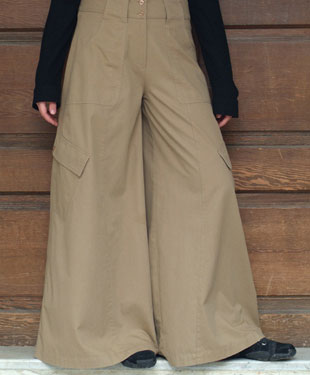Part Six (!) in the never-ending series of posts on modesty. Seriously, people, someone stop me.
Previous installments:
-
-
Modest or Immodest: a Handy Guide for Telling the Difference
-
Topless and Totally Modest (a look at culture’s effect on modesty)
-
-
I’ve been sharing a lot about my thoughts about “modesty” the last couple weeks. I put “modesty” in quotes there because anyone who has been reading along will realize that overall I don’t agree with the way we talk about modesty as a sexual issue, and I don’t like the spiritualization of the issue by taking Biblical terms and using them in completely different contexts.
On the other hand, quite a few people have written me and said something along the lines of, “If you don’t believe in a rules-based modesty code, how do you talk to your daughters about it? If you think it’s about character over obedience, how do you shape that character in your kids?”
Which are really fair, excellent questions.
Here comes the disclaimer: I’m going to share how I interact with my kids on this sort of topic. They’re all girls, aged 14, 12 and 6. None of them are dating. What I’m sharing here is not meant to be a guide, a suggestion, or intended to say I have it figured out. Kids are individuals and parents are individuals and what works for us might be a disaster for you and vice versa. But people have been asking, and I think it’s a good question.
I thought about this quite a bit, trying to bring to mind specific times I sat down with my daughters and “talked about modesty” and I honestly couldn’t think of a single specific occurrence. I don’t think we’ve done that. I felt a vague panic at the thought… did I miss it? Have I doomed my children to be scantily-clad troublemakers?
It seems unlikely. By most people’s definitions (even those I disagree with) they would be considered “modest.”
I did, however, as I thought about it more, realize there are some pretty specific ways we’ve talked about appropriate and inappropriate clothing and what to wear when and where. Here are four basic sorts of approaches we’ve taken. I think the first one will amuse you.
- Legalism.
Like it or not, legalism is necessary with kids, especially when they’re young. There’s a constant flood of information and instruction going to your kids as you’re attempting to socialize them, protect them and help them learn to become autonomous enough for you to get a nap. That means you’re often listing out rules for toddlers and small children, like:
- Look both ways before you cross the street.
- Use your fork.
- Don’t eat the candy the stranger gave you.
- Don’t hit people when you are angry.
Mixed in there with all the others, and no doubt indistinguishable for the children, are instructions like:
- Pull your shirt down from over your face.
- Please don’t put your finger in your nose/ear/mouth/butt in public.
- You need to wear something over your panties.
- Put your clothes back on.
- Please don’t run naked through the house.
- No really, get back here.
- Stop fighting me!
- Yes, you really do have to wear a nightgown to bed.

In the “modesty” realm, we’re largely teaching children cultural expectations. At church we wear this. At the pool we wear this. At bedtime we wear this. Zippers are not musical instruments. Buttons have to match the holes. Et cetera.
All that to say: the “rules” are an important teaching tool, especially when there’s a lot to teach and not much time for questions. Legalism is great when you don’t want questions.
Which is why, of course, the second great tool (which we have employed simultaneously with “the rules”) is questions!
2. Questions.
When you’re teaching people to follow rules, especially culturally-coded rules, questions are a nuisance. “Why do men wear a swatch of cloth hanging from their neck at special occasions?”
“Gee, I don’t know kid, now put on your tie.”
“Why do some people say pants are not appropriate for women to wear to church when they actually cover more than a mid-length skirt does?”
“Uhhhhh…. the Bible? Or something?”
In our family, we started with questions early on. As the kids grow up, the number of rules drop off quickly and the number of questions increase. The type and frequency of questions change as they age, but this is something we started with early on (with as simple a question as “What would you like to wear today?” for toddlers).
Asking questions teaches my kids two things: To see the underlying reasons for why what they are wearing is appropriate or not, and to become introspective about their own motivations in what they choose to wear.
So I might ask the question back to my daughter: “Why do you think pants are considered immodest in that church?”
She might say, “I guess it’s just a thing about that church.” (Which is right… she’s recognized it as a cultural phenomenon). Or maybe she talked to someone at the church and already knows the common reasoning for this: “They say that pants are ‘men’s clothing’ and the Bible says men shouldn’t wear women’s clothing and women shouldn’t wear men’s clothing.”

Of course, scripture does say this. So I might ask, “Do you think that’s a good use of that verse?” or “Do you think of pants as men’s clothing?”
If you push against most modesty rules (i.e. “don’t wear clothing X”) in Christian community, the answer that comes back will be a generality rather than something specific: “The Bible says to be modest” or “don’t cause your brother to stumble.” Not something like, “The Bible talks about Clothing X and says Thing Y about it.” The Bible doesn’t mention Clothing X, of course. But “obviously” Clothing X is immodest “everyone knows” that. We often don’t know the reason for our cultural beliefs and worldview. I want to help my kids realize that (a) it’s a specific cultural norm of that church and (b) that it’s completely appropriate to wear pants in that church out of deference to those people and come home later and put on a skirt. Or, for that matter, just to not go to that church.
Questions also help with an introspective awareness of motives, feelings and ideas about what they are wearing.
This might be something like picking up my middle daughter from ballet. She’s wearing tights and a leotard. I might ask her a question like this: “I need to stop at the grocery store on the way home. Did you bring shorts? Or would you be comfortable coming into the store without shorts? Or would you like to wait in the car?”
I am letting her do two things here:
One, she’s thinking through her own position. I am not giving her rules or regulations. Is she comfortable? Would it be appropriate in this situation? It was fine to wear this in the ballet studio, is it fine in the grocery store?
Two, it lets us interact in another way that’s pretty important if you’re not going to lay out all the modesty rules: we get to talk about context and do some social theorizing.
- Context and social theorizing.
Let’s be honest, my twelve year old still needs help navigating the culture. She needs me to provide context.
How about that leotard/grocery store question? (She would be horrified if you thought she needed help on this topic now, so let’s say when she was seven or eight years old.)
She might ask me (questions!): “Do people usually wear leotards to the grocery store?”
I would give her context: “It’s not common. Maybe sometimes, like after an exercise class. It’s probably most typical that a woman would wear shorts over her leotard before going into a store.”
Wait? Did I just give her a rule? Am I back to legalism? No. I’m not telling her she must put on shorts. There will be no punishment or disapproval should she choose to go into the store without shorts. She is being given freedom to make a decision on her own.

Social theorizing comes in as she starts to make theories about what will happen based on her choices. So, she might say, “I don’t think it will be a big deal. No one will notice.”
This same process can happen in any situation.
Perhaps she is packing for a church camp which requires a “modest swimsuit” and she’s planning to pack her bikini.
I might give context, “Most churches mean ‘a one piece’ when they say modest swimsuit.” I might ask a question, “How will you feel if you are the only one in a bikini?”
Maybe she’ll push that she wants to wear her bikini, anyway. I might give more context, or I might ask her what her motivation is in wanting to wear the bikini, or I might ask her to do some social theorizing by asking a context question, “What do you think the camp will do if they don’t think your bikini is modest? Will they let you swim?”
But, again, I’d let her make the call. I might suggest she take both swimsuits so she can make a decision at the camp.
Which leads us to the last thing: Feedback.
- Feedback.
I have to revisit the decisions the kids make. We have to discuss or at least think about whether our social theories were correct or incorrect. Again, this may start with questions:
“How was camp? What swimsuit did you wear? How did you feel about that? How did people respond?”
Or: “Was it a big deal to wear your leotard into the store?”
Or: “Do you wish you have come into the store even though you didn’t have shorts?”
Feedback here might mean sharing your own opinion: “I don’t think it’s a big deal to run into the store, if you want to try that next time” or “You should just throw some shorts into your ballet bag so you don’t have to worry about it.”

For me (and again, not expecting others to agree here), I might say, “I don’t agree that bikinis are immodest.” Here I’m modeling that it’s okay to disagree with other people’s rules. I might follow up with, “I’m glad you wore your one-piece so you could swim with your friends.” Or whatever.
I will say this: the feedback tool is most effective when you’re praising kids for a job well done, giving them small bits of advice, or helping them sort out what exactly happened. If you’ve just been waiting to give them “the right answer” it’s a lecture, not feedback.
Four closing thoughts and I’m done:
- My wife shops with the kids for nearly all their clothes. There isn’t really an outfit in the house that’s outside our comfort zone, I don’t think. We haven’t had them clamoring for inappropriate outfits, but I figure if Krista is fine buying it then we don’t need to have a conversation once they put it on.
- There is one time I remember one of the kids wearing something I thought was indecent. She had hiked a skirt up so high there wasn’t much reason to wear it. I told her I thought she was wearing it wrong (she was). I asked her a couple questions. She pulled the skirt down. I dropped her off at school. No punishments, no threats, no use of the word modesty, no shame, no modesty rules to check her outfit against.
- I don’t think of this as a modesty issue, but I’ll just mention here that we start telling the kids when they are tiny that they get to choose how other people touch their bodies. That means if someone is getting tickled in the house and they say, “Stop!” we stop. We tell them what to do if someone touches them in a way they want, and what kind of touching is inappropriate. This is a message we’ve repeated pretty often. I don’t think it’s a “modesty” rule because being touched in a way you don’t like (or sexually molested, assaulted or raped) isn’t your fault, no matter what you’re wearing or what situation you are in. I want to make sure the kids know that.
- Some might object, “Your kids are going to make mistakes.” Yup. Then they’re going to learn from them. And when they go into new situations where they don’t know “the rules” they’ll be able to use their own ability to make decisions, recognize culture, theorize about social cues and quickly adapt, fit in and thrive. Kids who have been reared using only legalism won’t make mistakes so long as they stick to their own specific context. In new situations their only skill set will be finding an authority figure to give them a new list of rules, which can likewise have disastrous results.
Last night at dinner I asked my eldest daughter if we had ever talked about modesty. (This kid… I promise you whatever your definition of modesty is, she probably exceeds it. I’m pretty sure Krista is trying to get her to loosen up a little when she takes her out to buy clothes.)
She said, “Remember at school this year when the vice-principal took out a measuring tape and measured how long the girl’s shorts were, and if they were a centimeter too short she told them they couldn’t go to the end of the year party?”
I said, “Yeah, I remember that.” These weren’t even short shorts. This was a school administrator using power to control kids, and punishing them for it. Parents were completely confused. One mom thought she might have to special order shorts because her daughter’s legs are so long she couldn’t find any factory made shorts that were long enough to meet the school guidelines (this is public school). The junior high men thought it was so ridiculous they rolled their own shorts up in solidarity with the women.

Zoey nodded. “I said that was dumb. And you said you thought it was dumb, too.”
So yeah… I guess I do talk to my kids about modesty sometimes!
WHEW! That was a long one!
How about you? How do you talk to your kids about modesty? Or, if you don’t have kids, how did your parents talk to you about it?
Still to come: Sexism in the modesty conversation AND what does the Bible say about nudity

